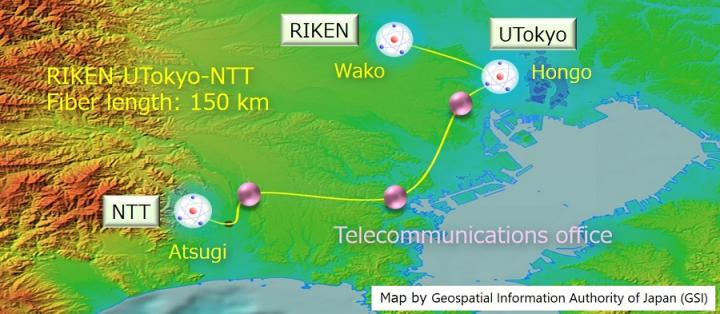Mar 18 2020
With the help of an optical telecommunications fiber network, a Japan-based team comprising academic and industrial researchers has linked three laboratories located in a 100-km region.
 Researchers connected three laboratories in a 100-km region with an optical telecommunications fiber network stable enough to connect optical atomic clocks. Image Credit: Tomoya Akatsuka, Nippon Telegraph and Telephone Corporation.
Researchers connected three laboratories in a 100-km region with an optical telecommunications fiber network stable enough to connect optical atomic clocks. Image Credit: Tomoya Akatsuka, Nippon Telegraph and Telephone Corporation.
The fiber network is sufficiently stable to remotely probe optical atomic clocks. A fiber link like this is set to expand the application of these highly accurate timekeepers by establishing an infrastructure that can potentially be utilized in an array of applications, like navigation and communication systems.
The laser system used for optical clocks is extremely complex and thus not practical to build at multiple locations. With our network scheme, a shared laser would enable an optical clock to operate remote clocks with much simpler laser systems.
Tomoya Akatsuka, Researcher, Nippon Telegraph and Telephone Corporation
Nippon Telegraph and Telephone Corporation (NTT) is a telecommunications company.
Scientists from the University of Tokyo, NTT, NTT East Corporation (NTT East), and RIKEN, all based in Japan, have reported the latest low-noise fiber link in Optics Express, the journal of The Optical Society (OSA).
“Optical clocks and optical fiber links have reached the stage where they can be put into practical use,” added Akatsuka. “Our system is compatible with existing optical communication systems and will help accelerate practical applications. For example, because optical clocks are sensitive to gravitational potential, linked clocks could be used for highly sensitive detection of early signs of earthquakes.”
Dealing with Noise
Since optical clocks are highly precise, noise is a major problem when connecting optical clocks across an extended fiber link. Noise can be introduced into the network even by slight temperature variations or vibrations and this interference impacts the laser signal such that it no longer reflects what initially emerged from the optical clock.
Although optical clock networks that simply connect distant clocks have been demonstrated in Europe, our scheme is more challenging because operating remote clocks with the delivered light requires a more stable fiber link.
Tomoya Akatsuka, Researcher, Nippon Telegraph and Telephone Corporation
Akatsuka continued, “In addition, the country’s urban environments tend to contribute more noise to fiber networks in Japan. To cope with that noise, we used a cascaded link that divides a long fiber into shorter spans connected by ultralow-noise laser repeater stations that incorporate planar lightwave circuits (PLCs).”
Optical interferometers formed on a tiny PLC chip were crucial for allowing a low-noise fiber link. Such interferometers were utilized in laser repeater stations that mimic the optical phase of the acquired light to a repeater laser. This repeater laser, in turn, is transmitted to a subsequent station with fiber noise compensation.
When noise compensation is applied for each short span, the laser signal becomes less sensitive to noise and thus becomes more stable.
Optical interferometers fabricated on a PLC chip have an unprecedented stability and provide a compact, robust and ultralow-noise optical system. This is very advantageous when constructing cascaded fiber links in noisy environments such as those found in Japan.
Tomoya Akatsuka, Researcher, Nippon Telegraph and Telephone Corporation
Connecting the Laboratories
To demonstrate the new optical system, the scientists delivered a laser light at a wavelength of 1397 nm via an optical fiber from RIKEN to NTT and the University of Tokyo. Then, with the help of another fiber link, the researchers quantified a beat signal between the shared lasers at NTT and the University of Tokyo to assess the stability of the fiber link for a fiber loop stretching 240 km.
As predicted, the outcomes demonstrated that the cascaded link was better when compared to that of a non-cascaded link.
The 1397 nm wavelength of the laser is twice that of the laser used for producing the highest stable type of optical clock called a strontium optical lattice clock. This implies that several distant strontium optical lattice clocks could be operated through a shared laser, using a fiber network.
Currently, the scientists are preparing optical lattice clocks to show a clock network utilizing this fiber link and are exploring ways to make the system’s electrical components more viable.
The study was partly funded by JST-Mirai Program (JPMJMI18A1), Japan and by JSPS Grant-in-Aid for Specially Promoted Research (JP16H06284).